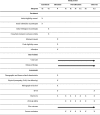The cost-effectiveness and cost-utility of at-home infrared temperature monitoring in reducing the incidence of foot ulcer recurrence in patients with diabetes (DIATEMP): study protocol for a randomized controlled trial
- PMID: 30249296
- PMCID: PMC6154404
- DOI: 10.1186/s13063-018-2890-2
The cost-effectiveness and cost-utility of at-home infrared temperature monitoring in reducing the incidence of foot ulcer recurrence in patients with diabetes (DIATEMP): study protocol for a randomized controlled trial
Abstract
Background: Home monitoring of foot temperatures in high-risk diabetes patients proves to be a promising approach for early recognition and treatment of pre-signs of ulceration, and thereby ulcer prevention. Despite previous studies demonstrating its efficacy, it is currently not widely applied in (Dutch) health care.
Methods: In a multicenter, outcome-assessor-blinded, randomized controlled trial, 304 patients with diabetes mellitus types I or II, loss of protective sensation based on peripheral neuropathy, and a history of foot ulceration in the preceding 4 years or a diagnosis of Charcot neuro-osteoarthropathy will be included. Enhanced therapy will consist of usual care and additional at-home daily measurement of foot temperatures at six to eight predefined locations on the foot. If a contralateral foot temperature difference of > 2.2 °C is found on two consecutive days, the participant is instructed to contact their podiatrist for further foot diagnosis or treatment, and to reduce ambulatory activity by 50% until temperatures are normalized. Enhanced therapy will be compared to usual care. The primary outcomes are the cost (savings) per patient without a foot ulcer (i.e., cost-effectiveness) and per quality-adjusted life year gained (i.e., cost-utility). The primary clinical outcome in the study is the proportion of patients with foot ulcer recurrence on the plantar foot, apical surfaces of the toes, the interdigital spaces or medial and lateral forefoot surfaces during 18-month follow-up.
Discussion: Confirmation of the efficacy of at-home foot temperature monitoring in ulcer prevention, together with assessing its usability, cost-effectiveness and cost-utility, could lead to implementation in Dutch health care, and in many settings across the world.
Trial registration: Netherlands Trial Registration: NTR5403 . Registered on 8 September 2015.
Keywords: Cost-effectiveness; Cost-utility; Diabetes mellitus; Diabetic foot; Diabetic foot ulcer; Foot temperature; Home-monitoring; Prevention; Ulcer recurrence.
Conflict of interest statement
Ethics approval and consent to participate
Ethical approval for the trial has been obtained by the METC of the Academic Medical Center in Amsterdam (NL 52735.018.115). Important protocol modifications are communicated to the accredited METC and only effective after a favorable opinion by the METC. Informed consent to participate in the trial is obtained from all participants. The trial is conducted according to the principles of the Declaration of Helsinki (64th version, October 2013) and in accordance with the Medical Research Involving Human Subjects Act.
Consent for publication
Not applicable.
Competing interests
The authors declare that they have no competing interests.
Publisher’s Note
Springer Nature remains neutral with regard to jurisdictional claims in published maps and institutional affiliations.
Figures

Similar articles
-
An integrated personalized assistive devices approach to reduce the risk of foot ulcer recurrence in diabetes (DIASSIST): study protocol for a multicenter randomized controlled trial.Trials. 2023 Oct 12;24(1):663. doi: 10.1186/s13063-023-07635-z. Trials. 2023. PMID: 37828618 Free PMC article.
-
Effectiveness of at-home skin temperature monitoring in reducing the incidence of foot ulcer recurrence in people with diabetes: a multicenter randomized controlled trial (DIATEMP).BMJ Open Diabetes Res Care. 2021 Sep;9(1):e002392. doi: 10.1136/bmjdrc-2021-002392. BMJ Open Diabetes Res Care. 2021. PMID: 34493496 Free PMC article. Clinical Trial.
-
Study protocol for a randomized controlled trial to test for preventive effects of diabetic foot ulceration by telemedicine that includes sensor-equipped insoles combined with photo documentation.Trials. 2019 Aug 22;20(1):521. doi: 10.1186/s13063-019-3623-x. Trials. 2019. PMID: 31439007 Free PMC article.
-
Prevention of foot ulcers in the at-risk patient with diabetes: a systematic review.Diabetes Metab Res Rev. 2020 Mar;36 Suppl 1:e3270. doi: 10.1002/dmrr.3270. Epub 2020 Jan 19. Diabetes Metab Res Rev. 2020. PMID: 31957213
-
Systematic reviews of wound care management: (3) antimicrobial agents for chronic wounds; (4) diabetic foot ulceration.Health Technol Assess. 2000;4(21):1-237. Health Technol Assess. 2000. PMID: 11074391 Review.
Cited by
-
An integrated personalized assistive devices approach to reduce the risk of foot ulcer recurrence in diabetes (DIASSIST): study protocol for a multicenter randomized controlled trial.Trials. 2023 Oct 12;24(1):663. doi: 10.1186/s13063-023-07635-z. Trials. 2023. PMID: 37828618 Free PMC article.
-
Effectiveness of at-home skin temperature monitoring in reducing the incidence of foot ulcer recurrence in people with diabetes: a multicenter randomized controlled trial (DIATEMP).BMJ Open Diabetes Res Care. 2021 Sep;9(1):e002392. doi: 10.1136/bmjdrc-2021-002392. BMJ Open Diabetes Res Care. 2021. PMID: 34493496 Free PMC article. Clinical Trial.
-
Analysis of Risk Factors Responsible for Neuropathy in Patients with Type 2 Diabetes Mellitus with Diabetic Foot During the COVID-19 Pandemic.Iran J Nurs Midwifery Res. 2023 Jan 27;28(1):85-91. doi: 10.4103/ijnmr.ijnmr_180_21. eCollection 2023 Jan-Feb. Iran J Nurs Midwifery Res. 2023. PMID: 37250947 Free PMC article.
-
Health-related quality of life and associated factors in people with diabetes at high risk of foot ulceration.J Foot Ankle Res. 2022 Nov 18;15(1):83. doi: 10.1186/s13047-022-00586-9. J Foot Ankle Res. 2022. PMID: 36401293 Free PMC article. Clinical Trial.
-
The efficacy of flexor tenotomy to prevent recurrent diabetic foot ulcers (DIAFLEX trial): Study protocol for a randomized controlled trial.Contemp Clin Trials Commun. 2023 Mar 11;33:101107. doi: 10.1016/j.conctc.2023.101107. eCollection 2023 Jun. Contemp Clin Trials Commun. 2023. PMID: 36950303 Free PMC article.
References
Publication types
MeSH terms
Grants and funding
LinkOut - more resources
Full Text Sources
Other Literature Sources
Medical

